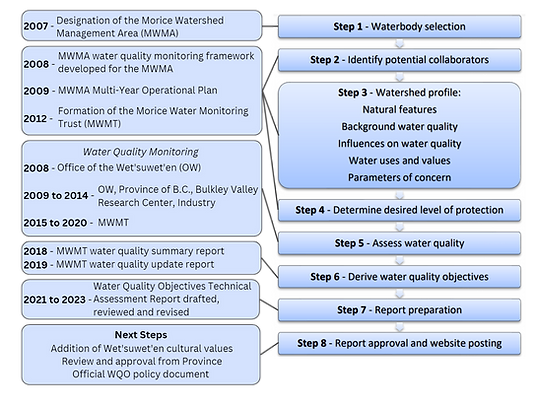

FIELD MONITORING
OVERVIEW
Water quality and quantity data is used to characterize waters, identify trends over time, identify emerging problems, determine whether pollution control programs are working, help direct pollution control efforts to where they are most needed, manage water use, and plan emergency responses to drought, floods and spills.
The Morice Water Management Area (MWMA) was established in 2007 by the Morice Land and Resource Management Plan with the intent to protect the hydrological integrity, water quality, water quantity, and fisheries of the upper Morice River watershed. Our water quality monitoring program began in 2015 to establish a scientifically valid baseline of water quality data that accounts for natural variation.
WATER QUALITY OBJECTIVES
Water Quality Objectives describe the conditions that should be met to protect an aquatic ecosystem. Objectives inform resource management decisions, identify which values should be addressed based on local concerns, promote water stewardship, and support long-term planning in communities. Water Quality Objectives are more specific than provincial Water Quality Guidelines, as they are informed by watershed assessments, and local and Indigenous knowledge.
Objectives in development for the Morice Watershed are intended to provide full protection of water resources, and to maintain existing water quality with no degradation, substantial alteration, or impairment by human activities.
Timeline of Water Quality Objectives
Development in the MWMA

WATER QUALITY DASHBOARD
Learn more about water quality in the Morice Watershed on our interactive Data Visualization Dashboard constructed by the Skeena Knowledge Trust. Data is uploaded from all water monitoring stations and results are shown in relation to Water Quality Objectives and Water Quality Guidelines.
